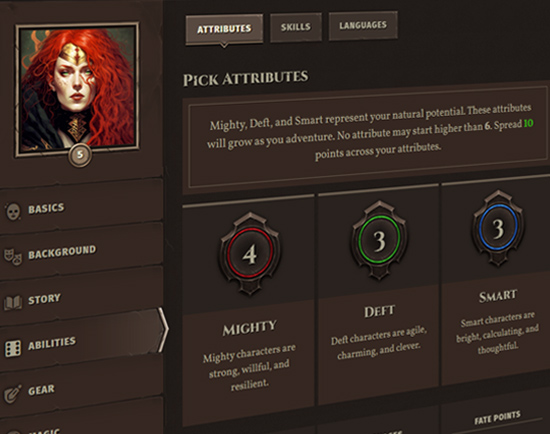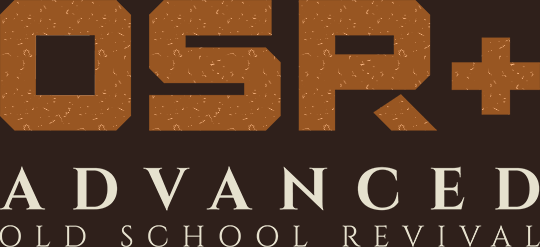In this section, we'll go over how to prepare your notes for an OSR+ adventure, making use of everything we've learned about adventure anatomy. We'll call this “the adventure” throughout, although prep for the adventure can also include creating a map for the overworld, as well as supplemental art, etc.
Throughout this section, we'll reference the notes for the OSR+ short Monsters in Merovia. This example adventure is a simplified version that's been stripped down to the bare minimum required to run it for illustrative purposes. (The full version of Monsters in Merovia has a randomized central villain and lots of variable scenes, which makes things a bit more complicated to run.)
What's in the Prep?
A single adventure might encompass all the scenes involved in a one-shot, or it might be part of a series of adventures in a campaign or short. Either way, the document addresses all the scenes that make up a single adventure. So if you're constructing a campaign, over time you will have many of these adventure documents. In the long-running epic fantasy campaign A Quest of Queens, for example, there are 7 adventures so far.
It's possible to write more than one adventure document so that players can bounce between them (using doorway scenes to connect them together), but more than likely, you're only going to need to prep one adventure document to work with over the course of however many sessions it takes to complete it. This is consistent with the idea that the players understand and accept the boundaries of play.
Anatomy of the Prep
There is no set number of sessions that an adventure breaks down into—this all depends on the cadence of play. However, in addition to the adventure prep, you may also prepare session notes as players progress through the adventure. These session notes incorporate recaps and precaps, update what's in the adventure prep, and supply new scenes to add to the adventure where necessary.
Overview
The overview is a very straightforward summary that puts the adventure in context: details about the setting, the status quo for its inhabitants when the adventure starts, and any other big picture lore that would be useful to have handy for quick reference. You can also include any special rules here that deviate from the OSR+ core rules.
GM Agenda
The GM agenda is a short summary of what's at stake and what the villain(s) are planning to do. In Monsters in Merovia, the GM can choose from a number of NPCs to establish the villain. In the sample adventure prep, the villain is Barmaid Lala, but Stahl the Druid and Milner Faolagan are also choices in the more complete version of the adventure.
Scenes
This is the meat of the adventure. You should allot at most a page or two of notes to each scene. Each scene includes:
- A call to action;
- Points of interest;
- Triggerable events;
- And discoveries.
The takeaway from a scene is always what adventure hooks it yields. Adventure hooks are to be found among the discoveries when the PCs explore the scene.
If your adventure has a lot of scenes, you might consider grouping floating scenes together so they're easier to reference and drop in (you will find a handful of floating scenes in the sample adventure grouped in this way).
NPC Stats
Keep all your NPCs' stats, written in NPC shorthand, in an appendix, sorted alphabetically. Make sure that any individual NPC's stats are not broken across more than one page, so you can quickly scan the NPC's stats at a glance. Because these stats are so brief in print, you could alternatively write out each NPC's stats on index cards.
Adventure Hook Map
Sometimes it's helpful to see how all your scenes interconnect by laying them out visually. You can start drafting an adventure by drawing all the potential scenes as bubbles on a single page, and then indicate an adventure hook for each bubble. This will allow you to see how well-reinforced each scene is, because all the adventure hooks are in one place to examine.
Here is an example of what Monsters of Merovia looks like when its scenes are visualized as an adventure web like this:
Reference Tables
Don't forget to keep all your random tables in one place. In OSR+, the best practice is to create tables with 6 to 12 options (12 if you want variety; 6 if you want your players to receive most of the options, but randomly).
Asset List
Assets can include images you want to share with your players to help them visualize things in the fiction, maps for the overworld or battlemaps for combat encounters, and (if you're playing in person) handouts. You may also count among your assets voice changers and playlists, which you can curate by the various moods that you anticipate the adventure requiring.
The Physical Setup
Always write your adventure prep with running it at the front of mind.
Considering the physical context in which you will run the game is important. If you're running it in person, will you be behind a GM screen? Will you be working off a tablet? If so, how will you bookmark the sections of your prep? Where will you place your NPC stats to reference? These are all questions you want to work out in advance, so you feel comfortable in your space. A physically comfortable GM is a confident one.
Formatting the Prep
You want to be able to scan your prep and know what it's communicating at a glance. This requires the prep to be written with lots of bullet points for brevity and obvious formatting clues that help you remember what you need to do in the scene. In the sample doc, you'll notice the following conventions used throughout.
Density of Text
You want to write concisely, as if you're communicating stage directions to yourself. For example, you don't need to tell yourself that the "PCs enter a mysterious cave full of distant glowing orange lights that appears empty except for a low hum that pervades the air." You already know what the cave is about and what's inside it. A more helpful note reminds you that "the grotto has 1d6 will-o'-the-wisps circling around a blood totem." Let yourself lean into atmospheric descriptions of what is to be found when you conduct play; your notes should only ever reflect the objective reality of the fiction you're trying to convey.
In other words: think sentences and bullet points, not paragraphs. Use keywords to jog your memory, as you might do when writing a screenplay.
Not Helpful: "Barmaid Lala: A waifish barmaid with curly red hair who is the daughter of survivors of aggression by the Dread Legion, she approaches the PCs with curiosity and offers generous table service. Lala is 5'4" and native to Merovia."
Helpful: "Barmaid Lala: Daphne from Fraiser. Bubbly. Curly red hair."
All that other fluff about how Lala behaves and where she comes from are extra bullet points you can surface if the opportunity arises.
Bullets & Heading Hierarchy
Try to be religious about how you organize scenes with heading levels and bulleted lists. When you write a scene, if it has to be more than a single printed page, then try to make sure no text overlaps to the next page mid-list or mid-paragraph, so if you have to flip pages, those two pages represent different contexts in the scene that have a natural pause between them.
For example, if one part of the scene involves rumors being discussed by townsfolk at a table, and another part is a list of the adventure hooks to be discovered, don't let the list of adventure hooks bleed over two pages—just put it on a separate page.
Heading Levels
You probably don’t need more than 3 heading levels: the title of the scene (heading level 1), topical or physical parts of the scene (heading level 2) and then, if necessary, headings for lists that outline points of interest within those parts (heading level 3).
Short Sentences
Don't ever write paragraphs of text (outside of dialog tags) longer than one or two sentences. If it needs to be longer, you’re probably trying to communicate something that needs to be in a bullet point.
Bulleted Lists
Each list item only ever communicates a single idea. If the list is about discoveries to be found in a room, each list item is a single discovery.
All this adds up to your being able to scan the page and know everything about the scene at a glance.
Text Formatting
At the end of the day, all the formatting and organization you do in your adventure prep serves the purpose of making things faster and easier to read. When you're running the game, you don't want to pause to read paragraphs or text or decipher the meaning of anything in your notes: the notes are there to prompt you. That's what the following formatting standards are all about.
BOLD Emphasis
Even in a bulleted list, you want to be able to glean the gist of the text without having to read the whole sentence. To this end, bold words that encapsulate that gist. Consider the following:
A viper under clay pitcher [M9 or 1d6 venom]. Pitcher rattles ominously when approached.
ALL CAPS FOR NPCS & MONSTERS
Use ALL CAPS when calling out anything that has stats in the NPC stats section. A reference to an NPC like STAHL means you can look up Stahl's stats if somebody decides to attack him. If he’s not in caps, that means he’s a non-adventuring NPC.
UNDERLINED Calls to Action
Underlined text indicates something actionable for the PCs. It's a reminder that you need to hand over the spotlight to the players for it to happen. For example: The PCs create an aspect of the tavern when they enter means you need to spotlight the players to construct the scene.
BRACKETED MECHANICS
Text in brackets indicates a mechanic or information that becomes player-facing when the fiction is further interrogated. For example: [M9 or 1d6 venom] means the PC needs a TN of 9 on a Mighty check, or else suffer 1d6 venom damage. The brackets in “Big conical stone edifice, older than town [of Changeling design]” mean that the fact that the edifice is of Changeling design is not something you volunteer to the players unless their PCs interrogate the fiction.
Parenthesis for Scenes
Text in parentheses set off indicates a scene for which there is additional prep. “For example, He sells [bogus] medicine to the (Constabulary).” The fact that Constabulary is in parenthesis indicates that this is a scene to be referenced in the prep.
 Archetypes
Archetypes Armor
Armor Classes
Classes Conflicts
Conflicts Cultures
Cultures Ethos
Ethos Flaws
Flaws Glossary
Glossary Kits
Kits Maleficence
Maleficence Origins
Origins Shields
Shields Skills
Skills Spells
Spells Stances
Stances Status Effects
Status Effects Tactics
Tactics Talents
Talents Techniques
Techniques Treasure
Treasure Weapons
Weapons











 Hall of Heroes
Hall of Heroes Hall of Legends
Hall of Legends



 Dungeons & Flagons
Dungeons & Flagons